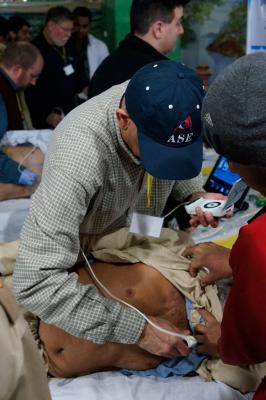January 19, 2014 — A paper in the journal of the World Heart Federation,
Global Heart, reported mounting evidence of the utility of
ultrasound in areas outside its traditional field of cardiology, with increasing use reported in general hospital wards, clinics and pre-hospital environments. The paper is by Associate Professor Bret Nelson and Dr. Amy Sanghvi, Mount Sinai School of Medicine, New York.
"The pervasive use of focused ultrasound is perhaps most evident in the advent of ultrasound
training in undergraduate medical curricula," the authors said. They refer to a 2011 review paper that highlighted the growing use of
point-of-care ultrasound by clinicians in over 20 specialties. "Increased training by clinicians across many specialties, coupled with technology improvements yielding lower cost and better quality studies, have contributed to this trend.”
The authors said prognostic value of emergency physician-performed
cardiac ultrasound has been demonstrated. Several studies have shown that no cardiac arrest patients without cardiac activity evident on ultrasound survived resuscitation. In general hospital wards and clinics, many studies have addressed the use of point-of-care ultrasound. A clinic-based study of first-year medical students instructed in the use of ultrasound demonstrated they were able to detect pathology in 75 percent of patients with known cardiac disease, where board-certified cardiologists using stethoscopes could detect only 49 percent. Pocket-sized ultrasound devices were used by general practitioners (GPs) in Norway to assess left ventricular function in patients with suspected heart failure. Here, 92 patients were assessed by GPs as well as cardiologists, and the measurements obtained with ultrasound by GPs correlated well with those obtained by cardiologists.
In environments where ambulances are staffed by physicians, Breitkreutz et al assessed patients in cardiac arrest as well as those receiving peri-arrest care. The FEEL (Focused Echocardiography Evaluation in Life Support) study demonstrated cardiac ultrasound changed management in 89 percent of the cardiac arrest patients and 66 percent of peri-arrest patients. The possibility also exists for ambulances to transmit ultrasound images to the in-hospital emergency teams awaiting arrival of incoming patients, with potentially life-saving implications.
The authors also refer to examples of ultrasound included in medical education curricula in Germany and the United States.
For more information: www.globalheart-journal.com


